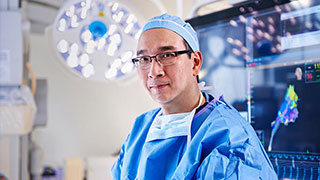What is Age Related Macular Degeneration?
Macular degeneration is an eye disorder that gradually causes loss of sharp central vision, causing difficulty in seeing details clearly. Because the condition most often affects people over age 60, it is often called age-related macular degeneration (AMD), and it is the leading cause of vision loss for that age group.
AMD causes damage to the macula, the center section of the retina at the back of the eye, and can affect one or both eyes. Because AMD affects central vision, it reduces the ability to carry out everyday activities such as driving, reading, writing, seeing faces, and doing close work such as cooking or household chores.
Advanced Care for Macular Degeneration
Ophthalmologists in UT Southwestern’s Macular Degeneration Program use the latest diagnostic technologies and treatment options to help people with AMD. To treat early AMD, we use the most current vitamin and mineral supplement treatments to slow vision loss and also recommend UV protection to preserve eyesight. For later stages, we offer the medications and leading-edge treatments to relieve symptoms, including the occasional use of laser therapy.
Stages of Age Related Macular Degeneration
AMD has three major stages, characterized by the size and number of drusen, yellow deposits beneath the retina that can be seen only during an eye exam. Some people have one eye with a later stage of AMD than the other. The stages are:
- Early AMD: This stage involves medium-sized drusen, which are about the width of a human hair. Vision loss usually has not yet occurred.
- Intermediate AMD: People at this stage usually have large drusen, pigment changes in the retina, or both. Intermediate AMD can cause some vision loss, but most people do not experience any symptoms.
- Late AMD: People with late AMD have drusen and vision loss from damage to the macula. The two types of late AMD are:
Types of Age Related Macular Degeneration
Geographic atrophy (also called dry AMD), in which the light-sensitive cells in the macula that transmit images to the brain begin to gradually deteriorate, along with the supporting tissue under the macula. These changes cause vision loss.
Neovascular AMD (also called wet AMD), in which abnormal blood vessels grow behind the macula and retina. These vessels can leak fluid and blood, which can lead to swelling and damage that can be rapid and severe, causing more vision loss than dry AMD. It is possible to have both dry and wet AMD in the same eye, and either condition can appear first.
Causes of Age Related Macular Degeneration
AMD results from damage to the blood vessels that nourish the macula. The exact causes of this damage are not well understood, but certain risk factors can increase a person’s chances of developing AMD:
- Family history of AMD
- Caucasian ancestry
- Smoking
- Poor nutrition
- Genetic factors
Symptoms of Age Related Macular Degeneration
Many people with AMD don’t experience symptoms in the early and intermediate stages. Patients who experience any of the following symptoms should see an eye specialist as soon as possible:
- Fuzzy or blurry vision
- Distorted vision, such as straight lines that appear wavy or colors that seem muddy or faded
- Dark or empty area in the center of vision
- Difficulty reading or doing other close activities
- Difficulty recognizing faces at a distance
Age Related Macular Degeneration Diagnosis
UT Southwestern ophthalmologists perform a comprehensive medical eye exam to detect AMD and determine its stage. The tests we use include:
- Vision test
- Dilated eye exam to check the retina and other structures inside the eye
- Amsler grid to check vision for distortion of straight lines
- Fluorescein angiography to see details of blood vessels in the back of the eye
- Optical coherence tomography to measure the retina’s thickness to check for swelling
- Fundus photography using a specialized microscope to show details of the retina, such as the presence of drusen
Age Related Macular Degeneration Treatments
Although there is currently no cure for AMD, new therapies are becoming available. At UT Southwestern, we offer treatments to help manage symptoms and slow the progression of the disease to improve our patients’ quality of life.
Patients can meet with a low-vision specialist, either an optometrist or an ophthalmologist, to talk about specific visual needs, such as reading. Our doctors can then recommend various optical aids, from magnifying lenses to closed circuit television, to help patients continue to participate in everyday visual activities.
Treatment options depend on the stage of AMD:
Early AMD:
- Monitoring: A comprehensive eye exam at least once a year
- Lifestyle changes: Smoking cessation, physical activity, and a healthy diet to help preserve vision
- AREDS2 formula: A combination of specific nutritional supplements that can slow the disease’s progression (only by doctor’s recommendation)
Intermediate and late AMD:
- Medications: Anti-vascular endothelial growth factor (anti-VEGF) drugs bevacizumab, Lucentis, and Eylea to treat the growth of abnormal blood vessels
- Photodynamic therapy: A light-sensitive drug activated by a laser to form a clot that closes abnormal blood vessels
- Photocoagulation therapy: Laser therapy to seal blood vessels and inhibit their growth









